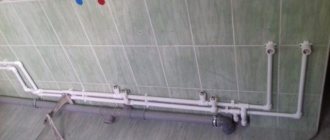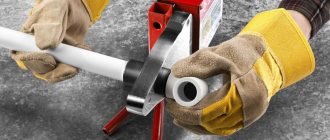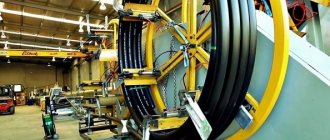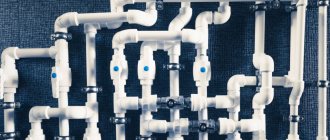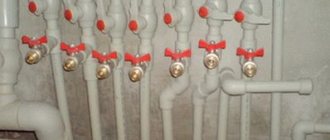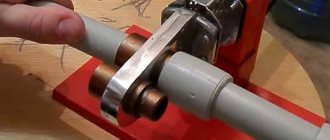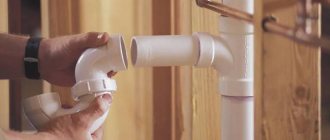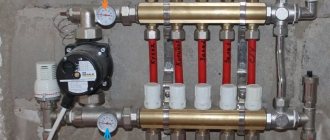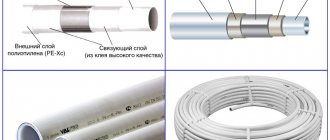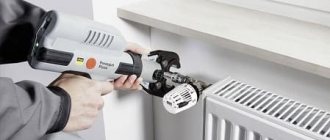SHARE ON SOCIAL NETWORKS
FacebookTwitterOkGoogle+PinterestVk
Polypropylene pipes are used to create reliable and durable water supply and heating systems. They are durable, resistant to high temperatures, high pressure, and mechanical stress. When installing a pipeline to connect its individual elements, make branches, transitions and turns, it is necessary to use a variety of fittings for polypropylene pipes.
Fittings provide reliable and durable pipe connections
Features of polypropylene pipes and fittings for them
Polypropylene pipes are very popular when installing hot and cold water supply systems, radiator and floor heating systems. This is explained by the fact that the products are characterized by strength, corrosion resistance, durability, resistance to high temperatures, and the ability to withstand freezing and thawing without changing the structure. Due to the presence of a smooth internal surface, the system does not become clogged and deposits do not accumulate in it, which is important for non-pressure sewer networks.
Polypropylene pipes are strong and durable
Products made of polypropylene (photos clearly show this) can be solid or reinforced. The first type is suitable for organizing a cold water supply line, and the second is more preferable for installing a hot water supply system and a heating network. This is explained by the fact that solid pipes under the influence of high temperatures are capable of deforming in length, which reinforced products lack due to the presence of a frame made of fiberglass or aluminum foil. This contributes to a low coefficient of thermal expansion.
To join pipes of the same or different diameters, to form branches, corners and contours, special elements called fittings for polypropylene are used. Thanks to such fittings, it is possible to shut off the system and, if necessary, dismantle it. With the help of these connecting elements, a backbone network of any configuration and complexity is created.
The connection of polypropylene pipes and fittings is carried out by soldering the components of the system. As a result, it is possible to obtain reliable and sealed connections, which guarantees uninterrupted and durable operation of the network. The process is quick and easy due to the fact that polypropylene products are chemically neutral.
Where are they used?
Polypropylene couplings can be used in the following engineering systems:
- water supply – cold, hot;
- heating – radiator, heated floors;
- conditioning;
- pipelines at industrial facilities through which various liquids move, including aggressive ones;
- melioration and irrigation networks;
- drainage.
Two different couplings in a heating system
Types of material for making polypropylene fittings
PP pipes and fittings can be made using polypropylene of different compositions, which affects the thermal stability of the product. Depending on this, there are three modifications of the starting material: homopolymer, random copolymer and block copolymer.
Polypropylene fittings are homopolymer, block and random copolymer
The first type of products is marked PRN or PP-1. The elements are made of polypropylene with the addition of modifying additives in the form of fire retardants, nucleators and antiseptics, thanks to which the final product has certain properties. Such pipes and fittings are used exclusively for the installation of a cold water supply network.
The second type of polypropylene pipes and fittings is marked PPCR, PRR, PP-3. The material has a crystalline structure, which allows products to withstand a wide range of temperatures (from -170 to +1300 °C) without compromising the integrity of the structure. This type of PPR pipes and fittings belongs to the universal class and can be used for the installation of any engineering communications.
Products made from block copolymer are designated PPV, PP-2, PP-S. For their manufacture, a polymer is used, consisting of homopolymer micromolecules, which are arranged in a certain order. These products are characterized by increased impact strength, the ability to withstand high temperatures without compromising the integrity of the material, good resistance to bending and abrasion, low vapor and gas permeability, and excellent dielectric properties. This type of pipes and fittings is ideal for organizing a main hot water supply network.
The characteristics of polypropylene include a parameter such as MRS, which indicates the shortest duration of strength. This indicator determines the maximum permissible pressure in the system at which pipes and fittings can last about 50 years when transporting water at a temperature of 20 ° C. This characteristic depends on the wall thickness of the products.
Block copolymer fittings are characterized by strength and resistance to temperature changes
The maximum permissible pressure value can be determined by the numerical value added to the abbreviation PN. The higher this indicator, the higher the pressure the pipe and fitting can withstand.
Types and diameters of polypropylene pipes
Polypropylene pipes and fittings for them can be classified depending on the nominal fluid pressure in the system. There are four groups of fittings: PN10, PN16, PN20 and PN25. The first class includes products with a small wall thickness. They are able to withstand pressures of up to 1 MPa and temperatures of transported liquids of up to 45 °C. Products are produced with a diameter of 20-110 mm, have a wall thickness of 1.9-11 mm. Such elements are ideal for installing a low-temperature underfloor heating system.
The marking of polypropylene pipes PN16 indicates that the products are designed for coolant temperatures up to 60 °C and operating pressure in the system up to 1.6 MPa. You can use such PP pipes and fittings for high pressure water supply. Products are produced with a diameter of 20-110 mm, wall thickness - 1.9-11 mm.
The third type of elements is designed for operating pressure in the system up to 2 MPa. The temperature of the pumped liquid can reach 80 °C. Pipes are produced with a diameter of 10-73 mm with a wall thickness of 1.6-11 mm. These products can be safely used for arranging water supply and heating systems.
Polypropylene pipes are available with diameters ranging from 2.15 to 7.8 cm
The last type of pipes, marked PN25, defines elements that can withstand pressures of up to 2.5 MPa and coolant temperatures of up to 95 ° C, which is achieved by reinforcing the elements with aluminum foil. The dimensions of polypropylene fittings and pipe dimensions are in the range of 21.5-78 mm (diameter), wall thickness - 2.7-16.4 mm. Such products can be used for installing a heating system and hot water supply line.
The diameter of the pipe is selected based on the throughput and resistance to the temperature of the pumped medium. Depending on this, for internal wiring of cold and hot water supply systems, you should choose products with a diameter of up to 25 mm. For external networks, elements measuring 40-100 mm are suitable. At the same time, for cold water supply, a cross-section of 20-40 mm and a wall thickness of 1.9-11 mm is sufficient, and for hot water it is worth purchasing products with a diameter of 20-100 with a wall size of 2.8-15 mm.
Helpful advice! To create a reliable and durable system, you should choose pipes and fittings with higher characteristics than declared.
For internal sewerage, products with a diameter of 32, 40, 65, 63 and 75 mm are used, and for external sewerage - at least 100 mm. The heating system is laid using elements with a cross section of 16-75 mm with a wall thickness of 3.4-10.5 mm, which is determined by the dimensions of the room and the type of boiler.
PP pipes are divided into four classes, which are marked: PN25, PN20, PN16 and PN10
System planning
Due to the fact that PPR pipes do not bend, when developing a wiring diagram it is necessary to create as few detours and turns as possible. After all, they are all made using fittings, and they have a significant cost (compared to a pipe). Therefore, we try to optimize the wiring - make as few turns, detours and bends as possible.
Serial (Tee) connection
Installation of water supply from polypropylene pipes with serial connection of consumers (plumbing and household appliances) is used in small systems. Usually they have 5-6 connection points. With this arrangement of the water supply system, one pipe leaves the riser and it sequentially bypasses all connection points. In the case of PPR plumbing, all branches are made using tees, which is why this type is also called tee.
Installation of water supply from polypropylene pipes with serial connection of consumers
The advantage of this system is that a small number of pipes are needed, and the disadvantage is that the pressure on each branch drops. As a result, with one or two working disassembly points, the third, located further from the riser, may simply not have enough pressure.
Parallel (collector) wiring
A parallel connection circuit is also called a collector circuit. This is because after the outlet from the riser, a special device is installed - a collector. This is an element with one input and a number of outputs. Available in polypropylene and metal. For water supply, polypropylene manifolds are more suitable (and cheaper).
The connection diagram is such that a separate pipe runs from each branch to each consumer (sometimes to a small group of consumers).
Parallel scheme for installing a water supply system from PPR pipes
The advantage of such a system is that the pressure at all water points is the same, the disadvantage is that a lot of pipes are required. Another plus is that if any branch fails, only one consumer does not work. The rest of the system is functioning normally. By the way, in order to be able to turn off individual devices, valves are installed at the outlet of the collector (usually ball valves, but if you need the ability to adjust the pressure, you can install a valve).
Plumbing and household appliances
In each method of installing a water supply system made of polypropylene pipes, a pipe is suitable for a specific consumer. There are two ways to connect to the system: flexible and rigid connection.
Rigid liner is more reliable: PPR pipes and fittings have high strength. Moreover, in this case there is only one thread - at the consumer connection point. But this type of eyeliner requires high precision: the error can be only a few millimeters. This is difficult to achieve when installing a polypropylene water supply with your own hands, so flexible hoses are often used. Just be careful, in some cases it is impossible to use it: connecting gas boilers or gas water heaters, supplying water to storage water heaters, water heated towel rails is recommended only using a rigid connection.
Rigid liner options
Soft eyeliner, on the contrary, does not require high precision - errors are leveled out by a flexible stainless steel braided hose or a hose that is used to connect a washing machine or dishwasher. The tubes are removed approximately in the area where the equipment is installed or the plumbing is connected. It ends with an adapter for metal, to which a flexible hose is connected (its other end is connected to the device).
Flexible hoses are connected to the adapters
This option is less reliable, since much depends on the quality of the flexible liner. Also not the most pleasant moment is the presence of two threaded connections, and this is a potential place for a leak to appear.
Fittings for polypropylene pipes: overview of shaped elements
To install water supply, sewerage and heating systems, it is necessary to purchase different types of fittings for polypropylene pipes, thanks to which network sections, branches, transitions, bypasses, and connections to plumbing fixtures are connected. The shaped parts are represented by socket elements, as a result of which they are put on the end of the pipes, which are preheated using a welding iron. The sizes of fittings in mm for polypropylene pipes are selected according to the dimensions of the products.
Important! PP pipes and fittings for them must be made of the same material and designed for the same pressure and temperature of the transported liquid.
Polypropylene fittings can be made entirely of plastic or combined, in which case metal inserts with external or internal threads are pressed into place. The first type of product is used for any method of laying a highway, including hidden ones. Such fittings are characterized by increased strength and at the same time have a higher cost. The system elements are connected by soldering, which ensures reliable and tight seams.
In combined products, metal is combined with polypropylene. Fittings of this type are used exclusively for open installation or with a combined installation method, which involves partial installation of false panels, covering with tiles, decorative grilles or plasterboard, which is necessary to monitor the condition of the connections.
Fittings are selected for a specific size of PP pipe
It is also important to know what types of fittings there are for polypropylene pipes based on their design principle. Shaped elements are divided into cast and segmented. The first option is represented by a one-piece product, which is characterized by maximum strength and reliability. Segment fittings consist of individual polypropylene elements that are connected by soldering. Such products have a large number of seams, which reduces their reliability, durability and cost.
“Hot” joining method: welding options
When using this method, 2 welding options are used:
- Soldering pipe to pipe is the most popular method.
- Fusion welding of couplings (adapters).
The first method is used when welding pipes with a diameter of more than 40 mm. The second is on pipes with a diameter from 16 to 40 mm. In this case, the fitting is needed not only to adjust the direction of pipe laying, but also as a supply of material for melting.
Various configurations of couplings (adapters) Source education-web.ru
Coupling configurations are selected based on the characteristics of the pipeline. The following types of adapters are available:
- Corners . Change of direction in any direction.
- Tees . Distribution of water supply and change of direction.
- Couplings . Docking without changing direction.
The following elements also apply:
- Bypass fittings.
- Ball valves.
- Combined products including metal-plastic.
- Threaded inside or outside pipes.
Types of fittings for polypropylene pipes with names
To connect two pipe sections of the same diameter, special couplings for polypropylene pipes that have thickened walls are used. Products are produced with a cross section of 20-160 mm. The coupling must be inserted into the pipe with some force. In this case, it is necessary that the pipe sections are absolutely smooth. Before installation, a fitting of the product is carried out, which fixes the pipe until it stops. It is subsequently heated using a low-temperature soldering iron and tightly connected to the fitting.
Helpful advice! Before installing a system made of polymer elements, you should study information on how to use an iron for polypropylene pipes.
If it is necessary to join two elements that have different sections or are made of different materials, adapter couplings with external or internal threads are used for the latter option. The products have different diameters - in the range of 20-75 mm, which can be learned in more detail from special tables of sizes of fittings for polypropylene pipes, which are easy to find on the Internet.
Different types of fittings are used to connect polypropylene pipes
To connect a polypropylene pipe to a flexible hose, fittings with a union nut are used. To change the direction of the pipe, squares and angles are used, providing a rotation of 45 or 90°. They can be straight (for connecting elements of the same cross-section) or transitional with internal or external threads, with or without a union nut. The sizes of fittings for polypropylene pipes are in the range of 20-160 mm.
To connect faucets, water sockets are often used, which are additionally equipped with special loops designed for fixing to the wall. In case of pipelines crossing each other or to overcome other obstacles, bypasses are used, which can be short, medium and long. Such products will allow you to change the direction of the highway smoothly - with a more round bend.
Important! Using the contours, you can rotate the highway by 120°.
Other types of fittings for polypropylene pipes
To make branches in one direction, polypropylene tees are used, which are produced in the form of straight, transition, one- and two-plane, manifold products. The latter option is more convenient due to the detachable connection.
Fitting tees are used to create branches
To branch the main pipe in two directions, polypropylene crosses are used, which can be one-, two-plane or coplanar. The latter type of product allows you to join polypropylene pipes located in the same plane, without the use of contours and bends. This solution helps preserve free space and gives the structure a more aesthetic appearance.
To protect the pipeline from dirt, rust and mechanical impurities, polypropylene filters are often installed. In order to prevent the reverse flow of liquid in the system in the event of a water hammer or stoppage of plumbing equipment, check valves with a threaded plug are installed on the line, which makes it possible to clean the mechanism. They are installed in front of water meters, boilers and water heaters.
To protect the pipeline from deformation changes in the event of a pressure or temperature difference, it is advisable to install compensators for polypropylene pipes. They are represented by curved sections of pipe in the form of a loop. Compensators for polypropylene pipes are mandatory when installing a heating and hot water supply system. To cover dead-end sections of the network, plugs, caps and plugs with and without threads are used.
Helpful advice! Plugs can be used when testing the system at any stage of its installation.
Fittings in the form of a ball valve allow you to close or open a pipe section
The fluid flow is controlled by valves. The plastered version of the product is used for hidden installation of the system. The radiator valve is used to connect the line to the radiator, eliminating the need to operate a combination coupling.
You can completely close or open the pipe section using a ball valve, which has two positions. This device is more durable, however, if there is any malfunction in its operation, the product will have to be completely replaced.
Related article:
PVC pipes for water supply: features of application and installation
Dimensions of plastic pipes for water supply and their correct connection. Creation of a summer water supply system at a summer cottage using plastic pipes.
Characteristic features of American pipes for polypropylene pipes
Another name for a fitting for polypropylene pipes, made in the form of a detachable coupling, is American. Such elements are additionally equipped with union nuts. American ones are used in systems that require periodic removal of elements for cleaning. Such fittings are often installed in front of meters.
Installation of the American is easy and quick, which is done by tightening the nut. This not only facilitates installation, but also makes it possible to instantly shut off the pipeline in case of leaks. This type of fitting is convenient to use when replacing a section of a network or inserting new inputs. In this case, the pipes are not destroyed due to their rotation, since they remain motionless.
American fittings are produced in the form of a detachable coupling
American fittings for polypropylene pipes are convenient to use for joining system elements in hard-to-reach places. Such fittings are equipped with their own seal, which eliminates the need to use additional gaskets, and the tightness of the connection is quite high.
Important! The American is considered a universal type of fitting and can be used as a coupling, adapter, plug and locking element.
Polypropylene American ones, depending on the design, come with internal or external threads, with a union nut and a solder end, as well as combined ones. The thread can be conical or cylindrical. The first option ensures high tightness of the connection without the use of additional gaskets and withstands the effects of aggressive environments and temperature changes. American women with cylindrical threads require the use of seals. Such units require periodic inspection with possible replacement of the worn gasket.
Choosing the right fitting by diameter - the main installation nuances
The diameter of the fitting can be selected exactly by name. You cannot adjust the fitting in diameter by chamfering inside the product. When choosing, pay attention to the pipe you are working with. There is always a marking on it that shows the outer diameter of the product. Without heating, the pipe will not fit into the fitting, since heating will help remove the top layer.
If everything is clear with the choice of the diameter of the polypropylene part, then when choosing the diameter of the thread, you need to be careful. For example, most polypropylene strips with water sockets come with an internal thread diameter of ¾ inches. However, there are options with a thread diameter of ½, which should be taken into account for specific equipment and looked at in the correspondence table.
As for advice, during soldering the fitting, as well as after finishing work, you need to adhere to the following rules:
- After soldering, you must make sure by touch or visually that the hole in the inner diameter of the channel has not undergone deformation. Otherwise, if there is sealing, the water in the system will pass through with an obstacle, which will lead to a decrease in pressure in the circuit.
- If you overexposed the fitting during soldering and it burst during the joining process, it is recommended to cut off the damaged part. It is prohibited to use a broken fitting, especially if you are going to lay the water supply under a screed or in a wall.
- After completing the welding of the water supply or heating circuit, it is recommended to perform a crimp test and check how well the circuit holds the set pressure. This is important before pouring the floor screed if the pipe will be hidden.
- Try to use fittings and pipes from the same manufacturer. Still, the composition of polypropylene, for better weldability of the material, should be the same.
- To correctly position the fitting relative to the plane in which it will lie, try it on and mark it in the form of stripes with a pencil. After heating, we simply join the notches. When soldering, make a notch on the pipe to a depth of 1.5 cm so that when you press it into the fitting, you do not crush or clog the hole inside.
- Observe the temperature regime of the soldering iron, do not overexpose the fitting when heating, monitor its appearance and the absence of factory damage.
Fittings for reinforced polypropylene pipes
To connect reinforced polypropylene pipes, pressed and compression type fittings are used, which are made in a brass body.
Compression and pressed fittings are used for PP-reinforced pipes
You can solve the question of how to make a detachable connection for polypropylene pipes using a compression fitting. The product consists of a body, a fitting, a ferrule nut and o-rings. The connection between the pipe and the shaped element is ensured by squeezing the sealing material when crimping the pipe. To do this, use an adjustable or open-end wrench to tighten the nut. The connection is characterized by reliability and durability. It can withstand pressure up to 35 bar. The service life is about 30 years.
Important! It is advisable to use compression fittings in an open installation of the system, where it is possible to observe the connection and periodically tighten the nuts if necessary.
The connection of polypropylene pipes without soldering is carried out using press fittings. Such fittings are represented by a body and a fitting with a crimp sleeve. To make a hermetically sealed connection you will need a special tool in the form of pliers. A system with such fittings can withstand high pressures of up to 75 bar, lasting about 50 years. It can be laid in both open and closed ways inside monolithic structures.
Differences from compression analogues
Due to inexperience and ignorance of all the nuances of installing metal-plastic pipes, press fittings can be confused with compression fittings. They also have a fitting and a sleeve. Only the latter is crimped not with a tool, but using the union nut included in the design.
The main difference between these parts is the different type of connection resulting from installation. The compression version can be disassembled if necessary, but this cannot be done with a pressed version. The press fitting can only be cut off from the pipe to be replaced with a new one.
If a leak develops at the connection point, the nut of the compression fitting can be tightened, but the maintenance-free press fitting will have to be completely removed (+)
However, the likelihood of a leak in the press connection is practically zero. It is not for nothing that this installation method is recommended for use when installing heated floors under screed and when embedding pipelines into the wall.
Cases when such fittings begin to leak in concrete occur extremely rarely in the practice of plumbers. This is more of an exception to the rule.
On the other hand, installation of both types of press fittings requires specialized tools. And to tighten the nuts of compression products, you only need a pair of wrenches.
As a result, on one side of the scale there is “expensive tools + higher reliability of the joint”, and on the other “no extra expenses + a slightly higher risk of leaks”. The choice here is only up to the master and the owner of the house where the pipeline is being laid.
Leading manufacturers of polypropylene pipe fittings
For the reliability and durability of the system, it is advisable to purchase PP pipes and fittings from one manufacturer. The following companies have proven themselves well in this industry.
The Wavin Ecoplastic brand produces high-quality fittings for polypropylene pipes
One of the best manufacturers is the German company Banninger Kunststoff-Produkte, which produces fittings from high-quality plastic, due to which the products are characterized by increased strength, chemical inertness, and the ability to easily withstand freezing. The shaped parts of this company are used for the installation of water supply and heating systems; they have a high price in comparison with analogues.
The Russian-Italian manufacturer Valtec produces polypropylene fittings with a conical bell shape, which significantly simplifies the system installation process. The company offers a wide range of products that are connected by soldering or threading. The maximum size of a polypropylene fitting is 50 mm.
The Czech company Wavin Ecoplastic produces various connecting elements made from neutral propylene. Pipes and fittings from this manufacturer are ideal for installing a drinking water pipeline. The Turkish company Tebo specializes in the manufacture of fittings with a diameter of 20-160 mm that can withstand system pressure up to 25 bar. The products of another Turkish company Kalde are characterized by high quality of straight and transition products of different sections, which can be used when installing water supply and heating systems.
Bell-shaped technology for assembling plastic pipelines
Fixation using this method is justified only when operating in low pressure systems. The insert into the socket ensures quick and easy installation, suitable for sewer and drainage engineering systems.
The ends of the pipes at the installation site must have a precisely adjusted diameter.
The section with the socket is, accordingly, inserted into the end of the pipe with a seal. The work will not require special knowledge or the purchase of special fittings.
The procedure for assembling pipelines by driving them into a socket
To eliminate possible diametrical errors in the joined sections, there is a rubber ring in the socket tip. The task of this element is to ensure tightness under mechanical stress on the pipeline.
Assembly of various polypropylene pipes Source www.uponor-usa.com
To facilitate the driving process itself, lubricant is used. The composition is applied to the smooth part of the end cut. The docking process is controlled using markings. This will prevent the user from driving the pipe too deep and damaging the section.
Normalized immersion of the bell allows not only to ensure material savings, but also to maintain a standard gap, which is necessary to compensate for loads during linear expansion - phenomena that occur with temperature differences.
Characteristic features of fittings for HDPE pipes
Low-density polyethylene is one of the types of polymers that is environmentally friendly, resistant to chemicals, able to withstand temperatures up to 80 ° C, abrasion resistance, high density, dielectric properties, good elasticity, which reduces the likelihood of damage due to water hammer. It is advisable to use this universal type of product for arranging cold water supply systems, sewerage systems, transportation of gaseous and liquid substances, as well as flammable gases.
Fittings for HDPE pipes are easy to install and last a long time
Helpful advice! There is a special type of polymer, the so-called cross-linked polyethylene, which is characterized by increased thermal stability, due to which it can be used for the installation of heating systems.
HDPE pipes and fittings can withstand pressure in the range of 6-16 atm. The products are characterized by a long service life, ease of installation and affordable cost.
Fittings for polyethylene pipes are produced in several types. To connect parts of the system, equal bore, compensation elements can be used, providing a transition from a larger diameter of products to a smaller one, and flange couplings (from a smaller section to a larger one).
Types of fittings for low pressure polyethylene pipes
Adapters are used to attach shut-off valves to the system. This type of fitting is used when connecting pipes made of different materials. To change the direction of the highway, bends with an angle of 45, 60 and 95° are installed. Tees and crosses are used to make branches.
Adapters, bends, crosses, tees, clamps, flanges are used to connect HDPE pipes
To create a secondary branch on the main line, you need saddles in the form of a clamp, crimp-type elements and linings, which are attached to the pipe by means of electrodiffusion welding. Such products are used for inserting new parts into an existing manifold and are often represented by fittings for 32 and 40 mm HDPE pipes.
Depending on the technology for connecting system elements, fittings for HDPE pipes can be one-piece, fixed using a welding machine, or prefabricated, which are mounted using plumbing wrenches. The second type of products is represented by compression, crimp, threaded, flange elements and press fittings.
One-piece products are designed for arranging an external water supply system. Installation of compression fittings for HDPE pipes is carried out using a union nut, and the reliability and tightness of the connection is ensured thanks to the O-ring. Threaded fittings are purchased for non-pressure systems and for joining cable ducts.
Flange elements are used when connecting a plastic pipeline to a metal one. Such products consist of a steel flange and bushing. The first part is fixed with studs or bolts to the mating flange, which is welded to the metal pipe, and the second part is connected to the plastic section of the line.
Flange fittings are used if you need to connect a HDPE pipe to a metal pipe
Briefly about the main thing
Lightweight, durable plastic pipes are easily connected to any materials in a variety of ways. There are detachable and non-detachable installation methods:
- The first option includes the use of compression fittings, threaded elements, and couplings.
- The second option uses “cold” and “hot” welding and gluing. The connection occurs using special compounds, for example, solder tapes and pastes, glue, epoxy resin, or simply by heating the plastic to the melting point.
When choosing how to connect metal-plastic with polypropylene at home, pay attention to the technology of compression fittings or threads with plastic elements.
Today, this is the only way to connect dissimilar sections, for example, cast iron and plastic. With compression fittings, the pipe connection can be quickly updated if necessary by replacing parts. The same cannot be said about the soldering method.
When there is no special tool at hand, electrical fittings can be used. Once connected, these elements quickly solder individual sections of the pipeline.
Before installation using the detachable method, you need to select fittings for the pipeline based on operational characteristics (temperature, pressure, dimensions). Fittings marked PPG are suitable for heating systems.
Features of using fittings for PVC pipes
Another type of polymer products are polyvinyl chloride pipes. They have found their application in the installation of cold water supply and sewerage systems. The material is characterized by strength, non-flammability, good dielectric properties, high density, and an increased level of rigidity. PVC pipes can withstand the temperature of the transported liquid up to 65 °C. If there is a strong impulse effect on the pipeline, it may be damaged.
Fittings for PVC pipes are distinguished by the same qualities as the material itself. Polyvinyl chloride elements can be used to create both internal and external water supply and drainage systems.
To organize the latter, products are used made from a special modification of plastic - unplasticized polyvinyl chloride (UPVC), the material is characterized by a high level of mechanical strength. A system that includes such elements can withstand high pressure, which is especially important for external pressure water supply and sewerage networks.
Fittings for PVC pipes are used for both external and internal connections
Important! For the installation of external systems, exclusively cast fittings are used, and for the internal network, segmented versions of fittings can be used.
Transitional coupling for reliable connection
The polypropylene transition coupling, as well as the split polypropylene coupling, are used for the installation of pipelines. It is lightweight, minimizes labor and time costs for pipeline installation, and is characterized by a long service life, practicality, durability and reliability due to the quality of workmanship and the material endowed with special properties.
The polypropylene transition coupling differs in type and diameter; it is selected based on the type and diameter of polypropylene pipes. Its feature is to ensure high connection reliability. Even after a long service life, it will not lose its properties and will clearly perform ozone functions.
